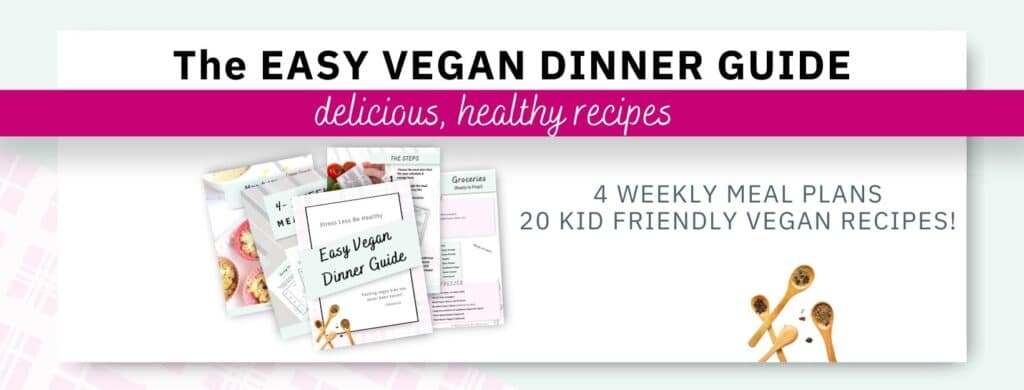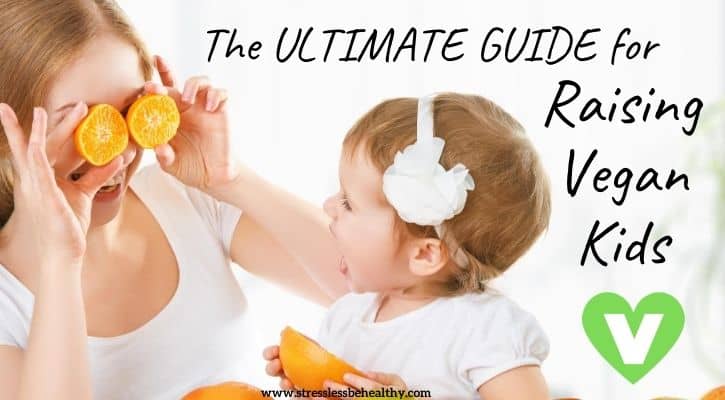Dietary Guidelines For Kids: How Vegan Kids Get The Nutrients They Need!
*Disclosure: some links may contain affiliate links. For more information on what this means, visit my disclosure page.
In the following articles you will learn the daily recommended amounts of different nutrients for all kids, vegan non-vegan alike, according to the Dietary Guidelines of 2015-2020¹ and the book Becoming Vegan: The Complete Reference to Plant-Based Nutrition (Comprehensive Edition)², by Branda Davis, RD & Vesanto Melina, MS, RD. Simply because those are what I’m most familiar with.
I’ll try to keep these articles to the point and then provide more information on each nutrient in different articles. So you can get into this article quickly, get what you need, and then find some recipes to help get those nutrients into your kids!
*Please note that I am not a doctor or registered dietitian and am not liable for what you do with the information I provide. The following is for informational purposes only. If you or you child has a medical condition or you have concerns about raising vegan kids, please consult your pediatrician or a registered dietitian familiar with a vegan diet.
Super quick dietary guidelines for kids; what nutrients do kids need in their diet?
Kids need the same nutrients that us adults do, simply in differing amounts. If you’re not sure of the nutrients you are supposed to have in your diet, according to the Dietary Guidelines they are:
- Macronutrients;
- Protein
- Fat (Yes, you need fat in your diet! And there are different types of fats; some are better than others)
- Carbohydrates (This includes sugars and dietary fiber, too)
- Minerals;
- Calcium
- Iron
- Magnesium
- Phosphorus
- Potassium
- Sodium
- Zinc
- Copper
- Manganese
- Selenium
- Chromium
- Fluoride
- Iodine
- Molybdenum
- Chloride
- Vitamins;
- A
- E
- D
- C
- B Vitamins
- 1: Thiamin
- 2: Riboflavin
- 3: Niacin
- 5: Pantothenic Acid
- 6
- 7: Biotin
- 9: Folate
- 12
- Choline
- K
*Please also note that the dietary guidelines discussed in this article may differ slightly from where you live, as many countries have their own dietary guidelines or recommended daily intake of nutrients. If you’d like, find your countries dietary guidelines, HERE.
Alight, now that you know how to teach your kids about a vegan diet (if you don’t know, you can start reading about that here), and which nutrients they need…
What do you feed them?
How much do they need?
And, how on Earth do you get them to eat it?
Those are the questions that we’ll start to answer in this article, and then you’ll want to continue reading this ultimate guide by clicking ‘CONTINUE READING’ at the end of this post.
If you’re not that interested in learning some basics of nutrition and just want to know how to build a healthy plate of foods for kids, read THIS.
But first, let’s discuss a bit of a touchy topic; calories.
Calories for Kids
Honestly, I don’t pay much attention to calories, and you shouldn’t either!
A calorie is simply a unit of energy.
When you consume a lot of calories and don’t use the extra calories with physical activities, those calories get stored.
If you consume less calories than you burn through physical activity, the stored calories, or units of energy, get used
Stop stressing over counting calories!
Seriously, it’s a waste of time…
UNLESS your child’s doctor tells you otherwise.
If you’re not sure why a doctor would want to have you keeping track of calories for kids, the most common reasons would include;
- Child needs to gain weight
- Child needs to lose weight
- Child has a medical condition in which counting calories is a requirement or helps in some way
If the pediatrician (or dietitian) doesn’t tell you to do it, then why stress about it?
Counting calories is not generally productive or helpful in most situations and may cause your child to think something is wrong with them, or produce a poor self image because they may think they need to lose weight or change themselves, depending on their age and where they are developmentally.
Instead of counting calories, if you think your child should gain or lose weight, choose food options for them to choose from that will help. And no, I don’t mean giving them junk to gain weight or ‘diet’ foods to lose.
If they are starting to get on the heavier side, encourage water as the main drink everyday, it should be anyways!
Encourage more veggies.
Limit junk food, processed foods, fake processed meats.
Obviously, they are vegan or transitioning to a vegan diet, so you shouldn’t have to worry about animal products. But, avoiding those will also help with weight loss, along with adding in a number of health benefits!
If your child needs to gain weight, which tends to be a bit more common with vegan kids, there are a few things you could do.
Add more healthy fats to their diet.
Make sure they are actually eating the 3 meals and snacks you are providing throughout the day.
Add extra calories anywhere you can in their diet (make sure they come from whole healthy plants!).
Don’t let them fill up on water before, or during, meals.
Macronutrients
Let’s get into macronutrients!
These are the things you may remember learning about in health class, I’ll briefly go over them, you know, in case you forgot!
First, if you want a little nutrition knowledge of macronutrients, here are the caloric values per nutrition type:
- Carbs: 4 calories per gram
- Fats: 9 calories per gram
- Protein: 4 calories per gram
*Water, vitamins, and minerals add no calories to the diet by themselves.
Again, don’t worry about counting calories.
But, do you see how fats have more calories per gram than the others?
That’s important…We’ll start with fats, in case you need help getting your kids to gain weight.
Fats
Fats have the most calories per gram and will be easier for your child to eat and gain weight, because they won’t have to eat as much.
There are different types of fats, such as saturated, unsaturated, and cholesterol. And then those could be broken up into different groups, as well. But, as vegans, we’ll mostly focus on the unsaturated fats.
Some healthy food high in fats are;
- Avocado
- Nuts, nut creams, and nut butters (like peanut butter! My kids eat peanut butter by the spoonful.)
- Full fat non-dairy milk (like full fat soy or coconut milk)
- Tofu
Healthy fats are an important part of a child’s diet, no matter their weight.
They need fats for optimal growth, specifically for brain, nervous system, and heart health.
You’ve probably heard of omega-3 fatty acids, or omega-6’s. That’s because those are essential fats, meaning you can only get them from food and the body cannot make them by itself.
Some people think that the only way to get omega-3 fatty acids is through fish.
Luckily that is not true, there are vegan sources of omega-3’s (EPA/DHA), as well. Such as;
- Walnuts
- Chia seeds
- Flaxseeds
- Hempseeds
- Wheat germ
- Oils of the above and other certain types of plant oils
- Breastmilk
- And of course, there is a vegan supplement that could be taken if need be!
Now that your memory is jogged a little bit, or you’ve learned a little bit, about fats; how much do your kids need?
The amount of fat your child needs is based on a percentage of their food intake of the day. Remember that there are carbs, fats, and proteins; those are the macronutrients. Of those three macronutrients, kids needs are;
- 55% of total calories for infants up to 6 months²
- 40% for 6-12 months²
- 30-40% for 1-3 year olds²
- 25-35% for 4-18 year olds²
I know I said don’t count calories, so the best way to make sure your child is getting enough fats is to pay attention to what they are eating and make sure they are getting some of the foods listed above!
This could be as simple as giving your child;
- Avocado and tomato toast with tofu scramble and full fat non-dairy milk for breakfast
- A smoothie with flaxseeds, chia seeds, and hempseeds, along with non-dairy milk, fruit of choice, and leafy greens as a snack
- A peanut butter and banana sandwich for lunch
- Energy balls made out of nuts, including walnuts, for another snack
- And so on…
Next We Will Discuss The Famous Question Everyone Loves to Ask “Where do vegans get their protein?”
Didn’t start from the beginning? Start Here!
Need some inspiration for being or raising vegan? Check out the vegan quotes in Vegan Quotes: For Health, the Planet, & the Animals!

¹Dietary Guidelines of 2015-2020
²Becoming Vegan: The Complete Reference to Plant-Based Nutrition (Comprehensive Edition), by Branda Davis, RD & Vesanto Melina, MS, RD







